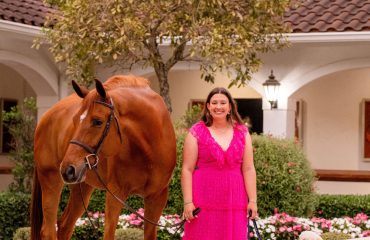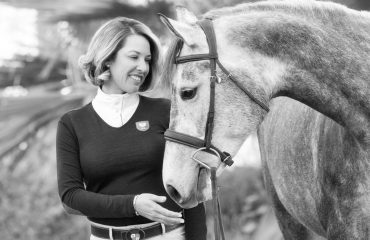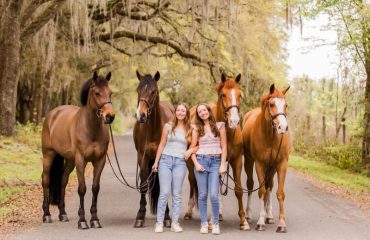 By Britney Grover
By Britney Grover
Photos by Rebecca Tolman
Quarter Horses, rodeos and cattle work are the predominant elements of the equestrian scene in Utah. Western horses and riders outnumber English perhaps 10-1. But last March, hunter-jumper trainer Sara Kirby defied the odds and helped bring a little more exposure to the Utah English equestrian community when she became the first English trainer — and the first woman — to win the Utah Horse Trainer Challenge.
“I had seen Facebook posts about it for the last couple of years, and have been intrigued by the concept,” Sara said. “Honestly, the prize money was really good, and I thought, You know, it’s during the winter when I’m not as busy, so why not, and I decided to do it. I had no idea what I was really getting into.”

Creekside Equestrian is in Payson, Utah, set against the backdrop of the Wasatch Front in the Rocky Mountains.
“Accidental” Beginning
Sara grew up in Roseburg, Oregon. “My parents were not horse people at all, and my older sister begged for a pony. My parents accidentally bought her one,” she said, and she wasn’t kidding. “They had asked a friend about how much horses cost, and he said, ‘Oh, I can find you a pony really cheap!’ They forgot about the conversation until about six months later when he called them up and said, ‘I’ve got your pony and I’ll deliver it tomorrow.’ He literally drove up a truck, unloaded a pony and drove away. My parents paid $75 for her, and that was the start of our horses.”
After getting her start riding the family pony up and down the driveway, Sara got involved in 4-H and Pony Club. She received her ‘HA’ rating from the Pony Club and competed in eventing, dressage and hunter-jumper. “I started teaching lessons while I was in college and riding horses for some people,” she said, “and it just grew and evolved until that was what I was doing full time.”
And that’s what she’s been doing ever since. She and her commendably supportive “horse hubby,” Patrick, moved to Payson, Utah, with their three daughters, Abby, Payton and Jocee — now 12, 9 and 6 years old — and established Creekside Equestrian Center. “When I moved in, I had neighbors stopping by to say hi, and they saw we had horses. When I said I did jumping horses, they didn’t quite know what to say,” Sara remembered of moving to the street where cattle drives — down the middle of the road — were more common than a saddle without a horn.
 At Creekside, Sara teaches students from adult to as young as 2 years old. She trains horses for clients in addition to her own to resell. She has trained many off-the-track Thoroughbreds as well as ponies and warmbloods — plenty of experience to use in the 60-day Utah Horse Council’s Horse Trainer Challenge, which would culminate in a public competition over a weekend at the Utah Horse Expo.
At Creekside, Sara teaches students from adult to as young as 2 years old. She trains horses for clients in addition to her own to resell. She has trained many off-the-track Thoroughbreds as well as ponies and warmbloods — plenty of experience to use in the 60-day Utah Horse Council’s Horse Trainer Challenge, which would culminate in a public competition over a weekend at the Utah Horse Expo.

Sara Kirby and Dolla. In just 60 days, Sara transformed Dolla from skittish and untouchable to friendly, calm and obedient.
Challenge Accepted
The tryout process for the Challenge began with a competition with each trainer on his or her own horse. They rode through a pattern in front of judges, and narrowed it down to six trainers. Each of the six trainers gave a demonstration with an unhandled yearling in a round pen, and from there they selected the four finalists, who were each given a 2-year-old filly. Sara was the first English trainer to ever be chosen as a finalist.
“I had envisioned that someone would hand me a lead rope, and I’d just take her home,” Sara said. “Instead, they were not even halter broke — the fillies were loose in the arena, and the people said, ‘There’s your horse, load it up.’ We ended up having to rope her and get her into the trailer, and when I got her home, I backed the trailer up to a stall and let her out because you couldn’t even touch her. She was completely wild. That was a little different than what I was expecting.”
With only 60 days to turn the small, skittish mare into a riding horse, it was all-hands-on-deck at Creekside. Any students who had some time to spare at the barn helped get Dolla used to humans, and Sara’s girls were an integral part. “The whole process, they were part of my training,” Sara said. “When I worked in the arena, lots of times I had them coming around and goofing off and playing with stuff to help get Dolla ready for being in front of a crowd.”

As part of the Utah Horse Expo, Dolla was auctioned off before the results of the Trainer Challenge. She was sold to one of Sara’s former students as a barrel prospect.
Two weeks before the Expo, Sara found out just how Western-weighted the competition really was: She would be required not just to ride Western, but to perform cattle work and roping on her filly. She borrowed a Western saddle, called on very limited Western experience from childhood, and she learned how to rope. “I worked on that,” she said. “I decided roping is a lot harder than it looks.”

Sara trained with anything and everything to prepare Dolla for the Utah Horse Trainer Challenge.
Odd Woman Out
From the onset, it was obvious that Sara was an outlier. “The first day of the Expo, I was wearing boots and breeches,” she remembered. “One of the other trainers looked at me and said, ‘Why are you dressed like that?’ ‘Because I’m gonna ride,’ I said. ‘…That’s what you wear?’” Sara laughed at the memory. “He was totally baffled that that was what I wore. Then I got teased because I polished my boots every day before we competed, and they didn’t quite understand that, either. But everybody was really, really nice at the Expo, even though I was the outsider. All of the Western trainers, riders and people at the Expo were really friendly and supportive.”
At the Expo, each of the four finalist trainers competed in six different events. “Each time that you competed, you were in the arena for anywhere from a half hour to an hour with a mic, and you were demonstrating what your horse could do but also teaching a clinic at the same time, explaining what you were doing and how you were doing it,” Sara said.

Dressed in pirate garb for their freestyle, Sara had to fire an antique black powder pistol to pop balloons with Dolla ground-tied behind her.
“The first time I successfully got a rope over a steer’s head was at the Expo, during the competition,” Sara said with a laugh. “It wasn’t very pretty, but I got it on there. It was really, really fun. We had to do team penning for the Expo, too. I will say I lost more points in the cattle work than in the entire rest of the competition combined. So I need to work on that!”
In another event, trainers were required to ground-tie their horses and use an antique black powder gun to pop balloons, searching for a paper within. “The first time I shot the gun, the gun went off but it didn’t pop a balloon. Then I had to shoot the gun again, but it wasn’t the right balloon,” Sara recalled. “Part of the rules was that if you shot the gun twice, they’d give you a sword. I had to pop every single balloon before I got the paper, and my filly did not move a muscle the entire time, even with everybody yelling. It made me cry, she was so good.”

Sara teaching a lesson to her daughter Abby on Monty, an OTTB Sara trained
Part of Both Worlds
Judges scored each trainer’s teaching and interaction with the audience, the horse’s performance and the training that was done on the spot. The audience also voted for their favorite trainer each day, and the most favorited trainer at the end of the week received a people’s choice award. By winning both the Horse Trainer Challenge and the people’s choice award, Sara now owns not just one but two Western saddles, and she learned a lot along the way.
“The fillies that we got were pretty hot and reactive; they weren’t your typical laidback Quarter Horses,” she said. “I remember standing outside the arena right before the final challenge and going, ‘Oh my gosh, I’m going to take this 2-year-old in there in front of a couple hundred people who are all yelling and screaming, and shoot guns and ride through stuff and pop balloons and do all this.’ Our show horses need to be exposed to a lot more.”

Sara’s teaching at Creekside Equestrian, with the Rocky Mountains behind
Since the Expo, Sara has been riding more Western — as have her girls. Sara bought several ponies with the Challenge winnings, including one Western-type horse, and now has several Western horses in training. Both Abby and Payton qualified for the State 4-H Western Championships, where 9-year-old Payton will show a 3-year-old pony in a test of her own training skills. When asked about her own goals for the future, Sara laughed.
“I really love teaching. I like training; I like having the variety of working with different types of horses and different events,” she said. She hopes to expand the family-oriented hunter schooling shows held at Creekside to include jumper shows, and also develop the working student program she began last summer, teaching students how to work with young horses and get them started under saddle. “They did a lot of work with my young projects, and were able to learn about all the groundwork and what we do in the first 60 days that a horse has under saddle,” she said, concluding, “That’s really not Western or English; it’s just good horse training.”
Photos by Rebecca Tolman of Impulsion Images Photography













